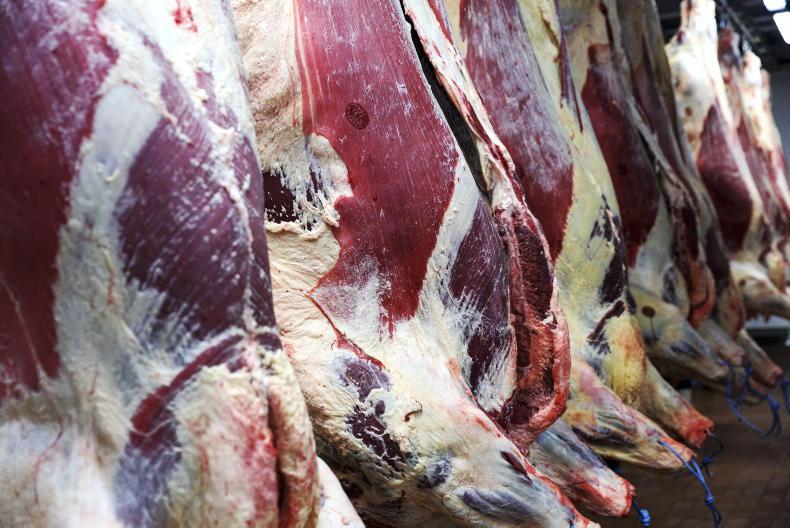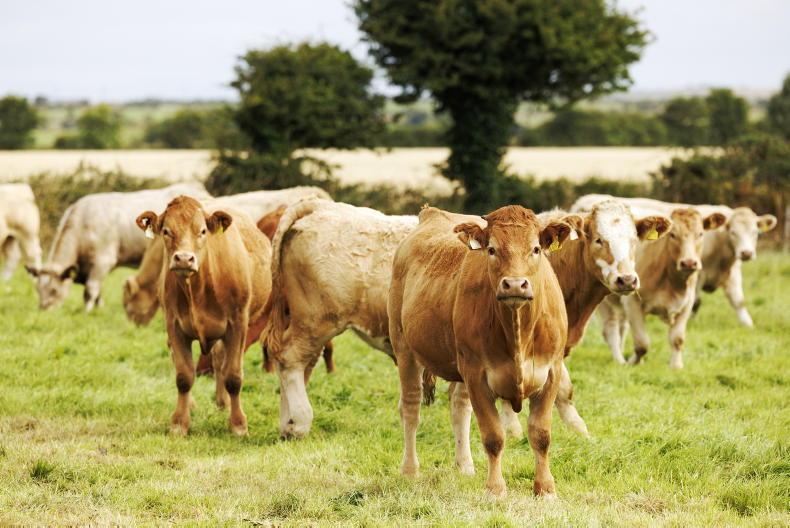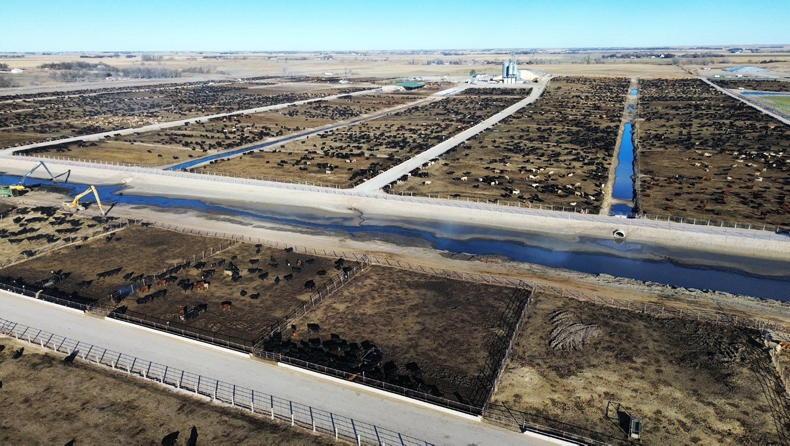While 2022 will be remembered as a year of record factory prices for cattle, combined with record input costs, the factory leagues also show a record price difference of €308 when comparing the €5.05/kg paid by Dunleavy Meats for a 360kg P+3= young bull compared with the €4.21/kg paid by the Dawn Charleville factory.
It is also almost €200 per head better for the best-grading U=3= young bull.
There is a variation across all the grades in the 16 categories of steers, heifers, young bulls and cows examined by the Irish Farmers Journal, ranging from the lowest of 18c/kg or €73.50 per head on R=3= steer to the high of €308.28 per head on P+3= young bull at the average 2022 slaughter weight.
How they work
The annual factory leagues are calculated on the prices paid for cattle by grade and reported every week in the Irish Farmers Journal.
It is a legal requirement for factories that kill over 20,000 cattle annually to report the prices. For the annual comparison, the Irish Farmers Journal takes four specific grades, U=3=, R=3=, O=3= and P+3=, for steers, heifers, young bulls and cows, to give 16 comparison tables.
While the numbers in these tables are as reported, they do not tell the full story about prices.
They are an aggregate of all prices paid so don’t reflect breed-specific or organic premiums paid.
They can also be distorted where some factories engage predominantly in flat-rate buying or have a variation to the grid prices, as is the case with Foyle Meats, where it pays higher prices to attract a narrow weight range of stock.
It also produces results like Jennings being second from bottom on U=3= heifer prices, while being top for O=3= and R=3= heifers and second from top for the P+3= heifer grade.
The other point to note is that, in some categories, very few cattle may be reported and, in some cases, such as U=3= cows, none at all were reported by several factories.
Where no cattle are reported, the factories in question are excluded from the table.
What the leagues do well at is show where different types of cattle sell best.
For example, for O=3= young bulls, three ABP factories, Bandon, Clones and Cahir, are all within a couple of cent of each other, while the Nenagh factory is over 20c/kg behind.
The greatest gaps between the top and bottom are found in young bulls and cows as some factories specialise in these, whereas others simply don’t want them at all and pay accordingly if any arrive. It is also common practice within groups to have a factory designated for different categories whether that is cows, speciality breeds or organic. The smallest gaps tend to be for steers and heifers as all factories handle these, though again there are some large variances such as with O=3= heifers where the spread between top and bottom is over €200/head for an average 340kg animal.
Award winners: year of glory for independents
When it comes to awarding medals for the top performers across the 16 grades examined, the smaller single-site factories dominate.
Jennings and Foyle are regular top performers and they are again prominent in 2022.
Jennings, which only handles steers and heifers, has landed four top positions and two second places in the eight categories it participates in across steers and heifers.
Foyle topped the table on in three categories, came second twice and picked up one third place.
However, there was competition for the top positions from the new entrants. Dunleavy Meats was particularly impressive, landing four top spots and one second place in its first full year of reporting.
The Traditional Meat Company (TMC) had picked up two golds and two silvers last year, but this year it is one gold and one bronze for TMC.
The second new entrant in 2022 is C&J Meats, which has featured prominently and claimed one gold and one silver medal.
ABP’s Bandon and Clones factories had one table-topping position each as did Dawn’s Dawn Meadow Meats factory.
Dawn Ballyhaunis came second on three occasions and third on three occasions also.
ABP Rathkeale finished second twice and also had two third places. Kepak Watergrasshill had one second and one third and ABP Cahir had two third places.
After two years of working around a global pandemic, 2022 looked set for a return to relative normality until Russia decided to invade Ukraine.
This triggered a global grain crisis followed by an energy and fertiliser price surge, reflecting Europe’s dependency on Russia for gas.
This meant an explosion in farm input costs, which was thankfully met by increased farmgate prices across all commodities, including beef where the national average price of R=3= steers increased by 72c/kg to almost €5/kg.
The Irish beef industry saw a reduction in retail demand as society opened up in the main markets from the pandemic and there was a corresponding increase in demand from the catering and hospitality sector.
The Irish Farmers Journal price leagues also feature two new entrants – Dunleavy Meats, Co Mayo, and C&J Meats, Co Donegal – which completed their first full year of price reporting.
It is notable that they, along with Traditional Meat Company, have joined Foyle Meats and Jennings in claiming so many top positions across the 16 different categories of cattle that are assessed.
Irish factory prices lagged behind the prices paid for cattle in our main export markets for much of 2022
C&J, while new to the market in the Republic of Ireland, has been a major buyer of carcase beef for its cutting plant in Co Armagh and it also has an interest in an abattoir in Northern Ireland.
Dunleavy Meats in Co Mayo is the king of young bulls, with three top place finishes and one second place.
Based on the national average, Irish factory prices lagged behind the prices paid for cattle in our main export markets for much of 2022, though the price surge towards the end of the year put Irish prices back in front as we enter 2023.
Striking
What was most striking was how we fell behind the second-largest beef exporter in Europe.
Poland traditionally lagged behind Irish prices by up to €1/kg for its young bulls compared to Irish steers. However, that turned in 2022 and for much of the year Polish young bulls were worth more than corresponding Irish steer beef.
Irish prices may have been constrained by the fact that all of the major groups have supply agreements with the top three British supermarkets and huge volumes of burger chain business.
Factories that aren’t locked into this type of business can be more agile in volatile markets where the spot price of beef is on the rise.
The opposite applies in a weak beef market, where factories supplying supermarkets and burger chains have the edge.
Leagues based on official prices reported including VAT.Prices at either end of tables can be distorted by small numbers reported.There are two new entrants, Dunleavy Meats and C&J Meats.
While 2022 will be remembered as a year of record factory prices for cattle, combined with record input costs, the factory leagues also show a record price difference of €308 when comparing the €5.05/kg paid by Dunleavy Meats for a 360kg P+3= young bull compared with the €4.21/kg paid by the Dawn Charleville factory.
It is also almost €200 per head better for the best-grading U=3= young bull.
There is a variation across all the grades in the 16 categories of steers, heifers, young bulls and cows examined by the Irish Farmers Journal, ranging from the lowest of 18c/kg or €73.50 per head on R=3= steer to the high of €308.28 per head on P+3= young bull at the average 2022 slaughter weight.
How they work
The annual factory leagues are calculated on the prices paid for cattle by grade and reported every week in the Irish Farmers Journal.
It is a legal requirement for factories that kill over 20,000 cattle annually to report the prices. For the annual comparison, the Irish Farmers Journal takes four specific grades, U=3=, R=3=, O=3= and P+3=, for steers, heifers, young bulls and cows, to give 16 comparison tables.
While the numbers in these tables are as reported, they do not tell the full story about prices.
They are an aggregate of all prices paid so don’t reflect breed-specific or organic premiums paid.
They can also be distorted where some factories engage predominantly in flat-rate buying or have a variation to the grid prices, as is the case with Foyle Meats, where it pays higher prices to attract a narrow weight range of stock.
It also produces results like Jennings being second from bottom on U=3= heifer prices, while being top for O=3= and R=3= heifers and second from top for the P+3= heifer grade.
The other point to note is that, in some categories, very few cattle may be reported and, in some cases, such as U=3= cows, none at all were reported by several factories.
Where no cattle are reported, the factories in question are excluded from the table.
What the leagues do well at is show where different types of cattle sell best.
For example, for O=3= young bulls, three ABP factories, Bandon, Clones and Cahir, are all within a couple of cent of each other, while the Nenagh factory is over 20c/kg behind.
The greatest gaps between the top and bottom are found in young bulls and cows as some factories specialise in these, whereas others simply don’t want them at all and pay accordingly if any arrive. It is also common practice within groups to have a factory designated for different categories whether that is cows, speciality breeds or organic. The smallest gaps tend to be for steers and heifers as all factories handle these, though again there are some large variances such as with O=3= heifers where the spread between top and bottom is over €200/head for an average 340kg animal.
Award winners: year of glory for independents
When it comes to awarding medals for the top performers across the 16 grades examined, the smaller single-site factories dominate.
Jennings and Foyle are regular top performers and they are again prominent in 2022.
Jennings, which only handles steers and heifers, has landed four top positions and two second places in the eight categories it participates in across steers and heifers.
Foyle topped the table on in three categories, came second twice and picked up one third place.
However, there was competition for the top positions from the new entrants. Dunleavy Meats was particularly impressive, landing four top spots and one second place in its first full year of reporting.
The Traditional Meat Company (TMC) had picked up two golds and two silvers last year, but this year it is one gold and one bronze for TMC.
The second new entrant in 2022 is C&J Meats, which has featured prominently and claimed one gold and one silver medal.
ABP’s Bandon and Clones factories had one table-topping position each as did Dawn’s Dawn Meadow Meats factory.
Dawn Ballyhaunis came second on three occasions and third on three occasions also.
ABP Rathkeale finished second twice and also had two third places. Kepak Watergrasshill had one second and one third and ABP Cahir had two third places.
After two years of working around a global pandemic, 2022 looked set for a return to relative normality until Russia decided to invade Ukraine.
This triggered a global grain crisis followed by an energy and fertiliser price surge, reflecting Europe’s dependency on Russia for gas.
This meant an explosion in farm input costs, which was thankfully met by increased farmgate prices across all commodities, including beef where the national average price of R=3= steers increased by 72c/kg to almost €5/kg.
The Irish beef industry saw a reduction in retail demand as society opened up in the main markets from the pandemic and there was a corresponding increase in demand from the catering and hospitality sector.
The Irish Farmers Journal price leagues also feature two new entrants – Dunleavy Meats, Co Mayo, and C&J Meats, Co Donegal – which completed their first full year of price reporting.
It is notable that they, along with Traditional Meat Company, have joined Foyle Meats and Jennings in claiming so many top positions across the 16 different categories of cattle that are assessed.
Irish factory prices lagged behind the prices paid for cattle in our main export markets for much of 2022
C&J, while new to the market in the Republic of Ireland, has been a major buyer of carcase beef for its cutting plant in Co Armagh and it also has an interest in an abattoir in Northern Ireland.
Dunleavy Meats in Co Mayo is the king of young bulls, with three top place finishes and one second place.
Based on the national average, Irish factory prices lagged behind the prices paid for cattle in our main export markets for much of 2022, though the price surge towards the end of the year put Irish prices back in front as we enter 2023.
Striking
What was most striking was how we fell behind the second-largest beef exporter in Europe.
Poland traditionally lagged behind Irish prices by up to €1/kg for its young bulls compared to Irish steers. However, that turned in 2022 and for much of the year Polish young bulls were worth more than corresponding Irish steer beef.
Irish prices may have been constrained by the fact that all of the major groups have supply agreements with the top three British supermarkets and huge volumes of burger chain business.
Factories that aren’t locked into this type of business can be more agile in volatile markets where the spot price of beef is on the rise.
The opposite applies in a weak beef market, where factories supplying supermarkets and burger chains have the edge.
Leagues based on official prices reported including VAT.Prices at either end of tables can be distorted by small numbers reported.There are two new entrants, Dunleavy Meats and C&J Meats. 









SHARING OPTIONS